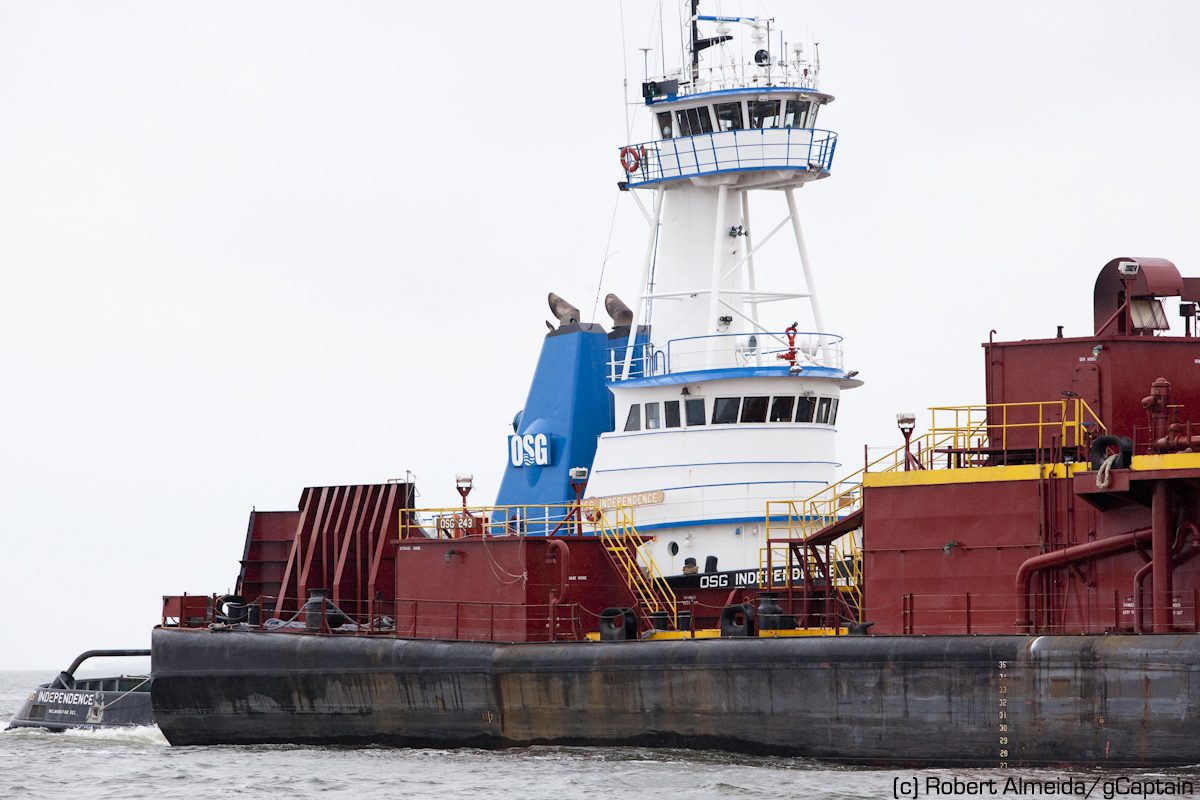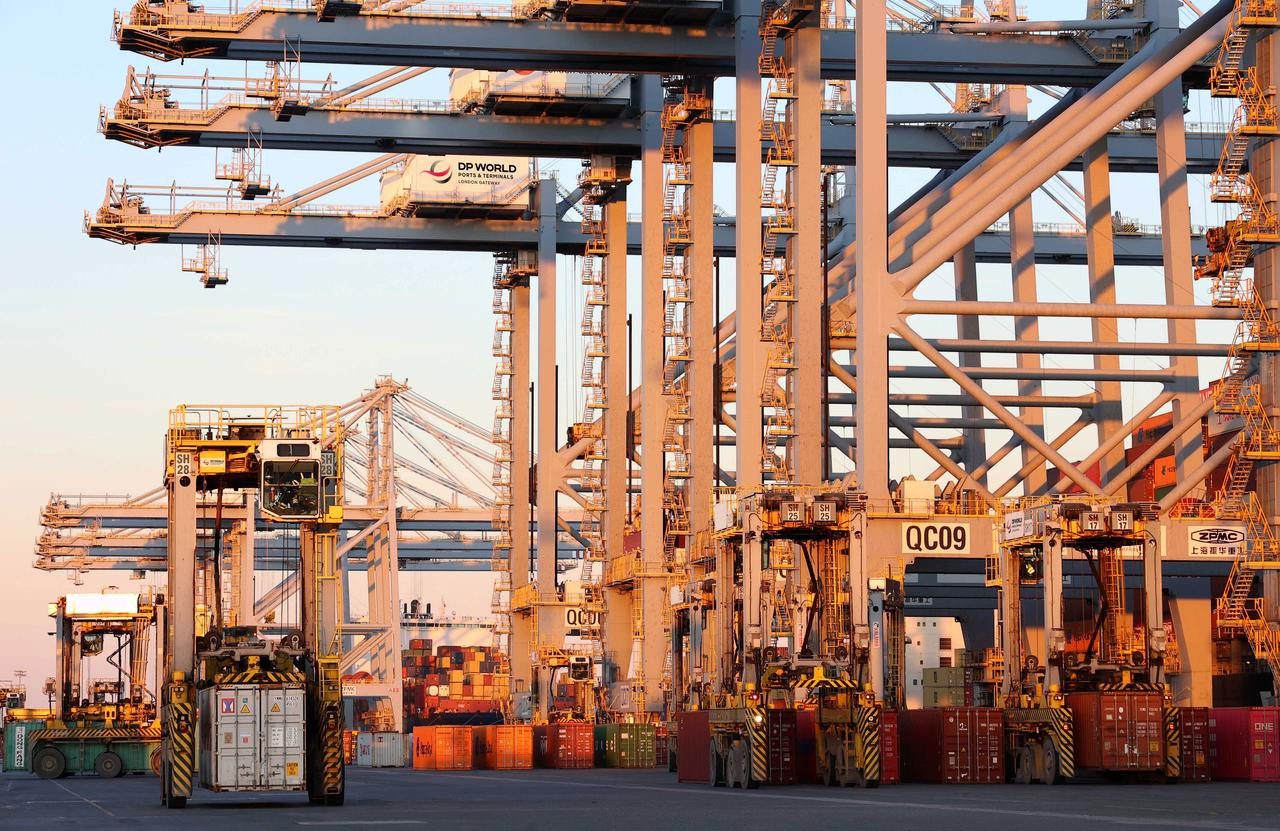OSG Independence pushes ahead on Delaware Bay, image (c) Rob Almeida/gCaptain
Overseas Shipholding Group Inc. is running out of cash and must renegotiate a loan agreement as an industrywide slowdown and rejection of a federal debt guarantee impedes profitability, challenging the company’s ability to pay its obligations and pay for new vessel deliveries next year.
The largest U.S. tanker company, which reported 13 straight quarters of net losses, will be about $100 million short of the funds it needs to repay $1.5 billion of loans by February even after it gets a new $900 million credit line that month, it said in an Aug. 7 regulatory filing. OSG also has $63.6 million of bonds maturing in December 2013.
OSG’s earnings have been squeezed by tanker rates that have fallen as much as 96 percent while fuel prices almost tripled since the end of 2008. The New York-based company’s attempt to improve liquidity through a federal loan guarantee was denied in February after reports that OSG ships had called on Iran’s largest oil port within the past year and U.S. House Majority Leader Eric Cantor called on the U.S. Transportation Department to reject the application.
“If they refinance the gap between the $1.5 billion and the new $900 million facility, they are left with no financial flexibility, and they still have to repay the bonds,” Roger King, a debt analyst at debt researcher CreditSights Inc. said in a telephone interview. “They’re going to need to make larger and loosen covenants on the new revolver. They’ll have a hard time finding new sources of capital.”
‘Adverse Impact’
OSG drew down the remaining $343 million under the $1.5 billion credit line, it said in an Aug. 1 statement announcing second-quarter results.
“Discussions are ongoing with our main banks to put in place long-term financing that provides sufficient liquidity to manage through an extended downturn,” Myles Itkin, chief financial officer, said during an Aug. 1 teleconference to discuss earnings with analysts and investors. Helen Harris, a Tampa-based communications manager for OSG, said the company declined to comment further.
The shipper is considering options to bridge the $100 million financing gap, it said in the Aug. 7 regulatory filing. If market conditions remain weak, OSG could see a “material adverse impact,” it said.
Bond Yields
OSG’s $146 million of 7.5 percent bonds due in February 2024 traded at 53.5 cents on the dollar on Aug. 13 to yield 16.7 percent, according to Trace, the bond price reporting system of the Financial Industry Regulatory Authority. Its $63 million of 8.75 percent bonds due in December 2013 last traded at 91 cents on the dollar on July 12. These notes are yielding 16.3 percent, Trace data show. The yields are more than double the average of 7.38 percent for all bonds in the Bank of America Merrill Lynch High Yield Master II index.
“The 2013 bondholders are assuming the new revolver will get funded and the company will do something to add liquidity,” King said. “I don’t think it’s a good bet, personally. For all the risk you are taking you’d want to be in the longer-dated bond.”
The price of marine fuel, the largest expense for tanker operators, is $663 a ton, up from $229 at the end of 2008. Bloomberg data show. Tanker rates from the Arabian Gulf to the Far East have fallen to $1,505 from $38,387, according to Poten & Partners, a transportation broker.
OSG is the successor to Maritime Overseas Corp., founded in 1948, according to its website. The firm has 112 vessels and $4.2 billion of assets.
Oldest Shipper
Other shipping companies are suffering from low transportation rates. Stephenson Clarke Shipping Ltd., the world’s oldest shipping company dating back to 1730, liquidated its fleet and said it is going out of business.
OSG’s shares, which traded at 7.15 cents at 10:14 a.m. in New York, have lost 35 percent so far this year, even as the S&P 500 index gained 13 percent. The stock closed as low as $5.55 cents on Aug. 2.
The shipper suspended its quarterly dividend on Feb. 9 to preserve cash amid the industry downturn, it said in a statement.
The company reported a second-quarter net loss of $55.3 million, or $1.83 per share, and cash flow from operations of $10.1 million. On June 30, 15 vessels comprising 29 percent of total book value of the company’s ships were pledged as collateral for secured loans.
Loan Guarantee
The owner of tankers that have called at Iran’s largest oil terminal over the past year had sought $241.8 million U.S. loan guarantee to mortgage two vessels in its fleet and use the proceeds as low-interest financing to “enhance its liquidity and maintain its financial flexibility,” the company said in a Feb. 17 regulatory filing. OSG withdrew its request after receiving indications it would be rejected by the U.S. Department of Transportation, according to the filing.
The withdrawal followed a European Union agreement on Jan. 23 to a phased-in ban on the purchase, transport, financing and insurance of Iranian oil. The sanctions apply to 95 percent of tankers because they are insured under rules governed by European law. OSG said the pool in which its ships operate would no longer go to Iran after the EU embargo on oil from the Persian Gulf nation.
‘Unencumbered Vessels’
Moody’s Investors Service lowered OSG’s credit rating on Aug. 2 to Caa1 from B3 and the shipper’s unsecured debt to Caa2 from Caa1, signaling “very high” credit risk, analysts led by Jonathan Root wrote in an Aug. 2 report
“What’s supportive is that they are an unsecured borrower and have a number of unencumbered vessels,” Root, a senior credit officer at Moody’s in New York, said in a telephone interview. “OSG maintains flexibility because it has assets it can pledge to solve this issue.”
Standard & Poor’s cut the company and its debt ratings to CCC+, five levels above default and a grade reserved for obligations that are “currently vulnerable to nonpayment” and dependent upon “favorable” business and economic obligations, according to a July 17 statement.
“For each of 2012 and 2013, we calculate a cash burn of about $110 million,” Root said. “The bogey for these guys is what will freight rates do? Operations won’t solve the problem, they need to raise cash.”
Average spot rates in OSG’s International Flag segments in the third and fourth quarters of 2011 were the lowest they’ve been during the industry’s cyclical downturn, which began in the fourth quarter of 2008, the company said in its Aug. 7 regulatory filing.
“The challenges to the company and industry from an operational perspective are weak global economic growth and too many ships,” Root said. “There’s little any one individual company can do to solve that problem.”

 Join The Club
Join The Club











